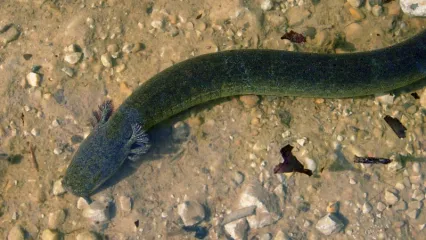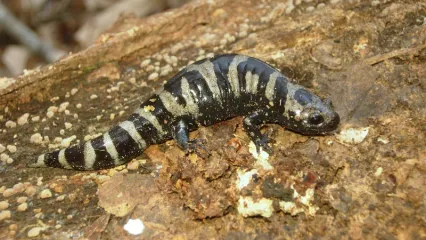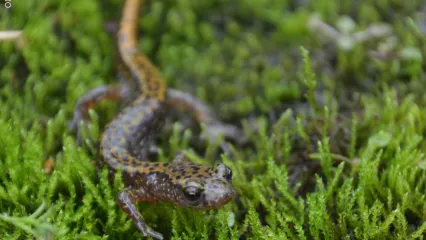
Description
Blanchard’s cricket frogs are among the smallest frogs in Oklahoma. They are often grayish brown with a small dark gray triangle between the eyes. Individuals may have a green, dark red, or gray stripe down the middle of the back. These frogs also have dark longitudinal stripes on the back of the thigh and extensive webbing on the foot.
Tadpoles are light brown to brown. The tail has dark brown saddles dorsally, and the fins are transparent with some darker flecking. The spiracular tube is long and is not attached to the body. Tail color varies depending on habitat. In temporary ponds with insect predators, especially dragonfly larvae, the end of the tail is black. The black spot deflects the attack of the dragonfly to the tail, avoiding damage to the tadpole’s body. In lakes or large ponds with fish, tails of the tadpoles do not have a black spot. Fish engulf their prey whole, so tadpoles avoid fish predation by being cryptic. Tadpoles require about two months to transform into froglets.
The calls of Blanchard’s cricket frogs are commonly heard during both night and day throughout the summer months. The call sounds like rubbing two marbles together.
Size
Blanchard’s cricket frogs are about 0.5 to 1.5 inches in length. By late July or August, tadpoles begin to metamorphose into juvenile frogs.
Habitat
Blanchard’s cricket frogs are among the most abundant frogs in Oklahoma. They occur in many different habitats, including small temporary ponds, large permanent ponds, swamps, streams and creeks, and lake edges.
Life Cycle
These frogs are primarily summer breeders, although the first calls can be heard in April. Eggs are laid singly scattered about in aquatic vegetation. Blanchard’s cricket frogs frequent the damp shorelines of their habitats. If frightened, they may dive into the water and burrow into the mud, or, if the habitat has a grassy or weedy edge, they may jump into the vegetation to hide. They are capable of long jumps, and they jump in a zig-zag pattern to foil would-be predators. Although Blanchard’s cricket frogs become inactive in winter, they can be seen abroad on warm days as early as late January or February.
How To Observe
Blanchard’s cricket frogs are most easily observed during daytime. They can be seen jumping about along the margins of nearly any suitable body of water. At night, they can be heard throughout the summer months and seen with the aid of a flashlight or headlamp.
(This profile was created by Dr. Laurie Vitt as part of a partnership between the Wildlife Department and the Sam Noble Oklahoma Museum of Natural History. It was funded as part of a larger State Wildlife Grant to survey and inventory amphibians and reptiles of the Wildlife Management Areas of Oklahoma: T-35-P-1.)


